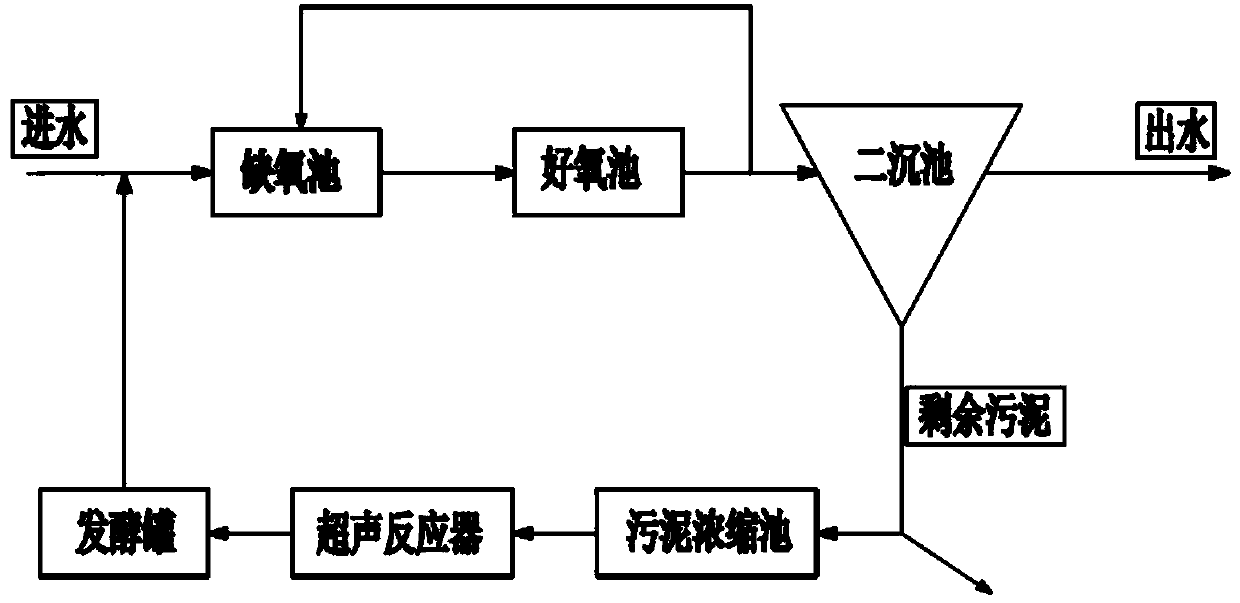Method for performing biological denitrification of wastewater by using residual sludge and biological denitrification system for implementing same
A technology for excess sludge and biological denitrification, which is applied in the field of biological denitrification systems, can solve the problems of increasing the operating costs of sewage treatment plants, failing to meet the standard of nitrogen indicators in the treated effluent, and reducing the effect of denitrification of the system, so as to solve the problem of denitrifying carbon sources. Insufficient, reduced processing costs, cost-saving effects
- Summary
- Abstract
- Description
- Claims
- Application Information
AI Technical Summary
Problems solved by technology
Method used
Image
Examples
Embodiment 1
[0038] Such as figure 1 The wastewater biological denitrification system shown includes anoxic tank, aerobic tank and secondary sedimentation tank connected in sequence. The anoxic tank is equipped with a water inlet, and the anoxic tank is equipped with a stirring device; the bottom of the aerobic tank is equipped with perforated aeration. Hollow plastic balls are hung in the aerobic tank, and filter cloth is installed inside the ball; an internal backflow device is installed between the aerobic tank and the anoxic tank, and the secondary settling tank is equipped with a water outlet and a sludge discharge port. A water quality detector is installed between them; a sludge thickening tank, an ultrasonic processor and an anaerobic fermentation tank are sequentially connected between the sludge outlet and the water inlet.
[0039] In this embodiment, a method for biological denitrification of wastewater using excess sludge is to use figure 1 The implementation of wastewater bio...
Embodiment 2
[0047] In this embodiment, a method for biological denitrification of wastewater by using excess sludge is also used figure 1 The implementation of wastewater biological denitrification system includes the following steps:
[0048] (1) Take domestic sewage from the canal section of Hangzhou City (hereinafter referred to as canal sewage), and feed it into the anoxic pool, with 30L of water in each batch, and control the DO in the anoxic pool to 15mg / L, and the reaction time in the anoxic pool is 2h;
[0049] A hollow plastic ball with a diameter of 7cm is suspended in the aerobic pool, and a 40-mesh filter cloth with a proportion of 70% is installed in the ball. Water earthworms are mounted in the filter cloth, and the loading capacity of water earthworms is 2kg / L canal sewage; DO is 4~6mg / L, after 6 hours of reaction, return the nitrification solution to the anoxic tank, the reflux ratio of the nitrification solution (reflux flow / influent flow) is 100%, when the total nitrogen...
Embodiment 3
[0054] In this embodiment, a method for biological denitrification of wastewater by using excess sludge is also used figure 1 The implementation of wastewater biological denitrification system includes the following steps:
[0055] (1) Take the domestic sewage from the canal section of Hangzhou City (hereinafter referred to as the canal sewage), and feed it into the anoxic pool. Each batch of water intake is 30L. The DO in the anoxic pool is controlled at 0.4mg / L, and the reaction time in the anoxic pool is 2h;
[0056] A hollow plastic ball with a diameter of 7cm is hung in the aerobic pool, and a 40-mesh filter cloth with a proportion of 60% is installed in the ball. Water earthworms are mounted in the filter cloth, and the loading capacity of water earthworms is 2kg / L canal sewage; control the aerobic pool DO is 4~6mg / L, after 6 hours of reaction, return the nitrification solution to the anoxic tank, the reflux ratio of the nitrification solution (reflux flow / influent flow)...
PUM
| Property | Measurement | Unit |
|---|---|---|
| diameter | aaaaa | aaaaa |
Abstract
Description
Claims
Application Information
 Login to View More
Login to View More - Generate Ideas
- Intellectual Property
- Life Sciences
- Materials
- Tech Scout
- Unparalleled Data Quality
- Higher Quality Content
- 60% Fewer Hallucinations
Browse by: Latest US Patents, China's latest patents, Technical Efficacy Thesaurus, Application Domain, Technology Topic, Popular Technical Reports.
© 2025 PatSnap. All rights reserved.Legal|Privacy policy|Modern Slavery Act Transparency Statement|Sitemap|About US| Contact US: help@patsnap.com


